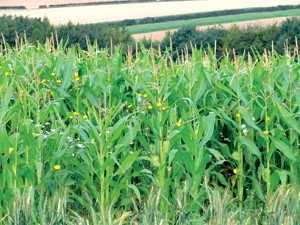News
Suitable soil and choosing a crop
Following the EU’s scrapping of compulsory set-aside and higher incomes from commercial crops, choosing and placing covercrops will be more vital than ever. David Lyles explains
Would you like to speak to our readers? We offer sponsored articles and advertising to put you in front of our audience. Find out more.
By now, you should have secured the areas for conservation plots with the farmer or estate for 2008. Checking the plots for suitability and matching them to the right crops is very important. Attention to detail is key do not assume that just because the previous crop looked all right that the next one will do as well. There are many factors that you should check before the seed catalogues arrive next month. Here are just a few.
Soil type
Establish the type of soil you are dealing with and its working characteristics. This is a relatively simple process, but one of the best tips is to gain some local information. Most farmers will share their knowledge with you, as it is very much part of their daily decision of how best to work the land. The main constituents affecting the classification of soil will be the levels of sand and clay. There is a simple test you can try. Pick up a small handful of moist soil and try to make a ball of it. If it falls apart and is difficult to mould, it will tend to have a higher fraction of sand. Conversely, if it is easy to make a ball there will be more clay. If the soil is about halfway, it will be described as loam. With a high sand content, it is known as loamy sand and with a higher clay content as loamy clay. However, there are other types of soil, such as peat, where there are large amounts of organic matter and where subsoils such as chalk are mixed in the profile. In these cases these rules do not apply so simply, so make sure you establish what soil you have and seek that invaluable local knowledge. Why is this classification important? It will affect decisions of how early you need to plough the land and what type of equipment you need to create a seedbed. It will also indicate if the soil is free draining, likely to be compacted or waterlogged and so on. The heavier the land, the more it will benefit from weathering to help break down the seedbed. Ploughing early enough to receive a frost or two will help.
Soil testing
It is fundamental when growing any crop to establish what level the soil nutrients are at before sowing. On a field scale the accepted means of averaging the sample is to walk over the plot in the shape of a W, taking small samples of the soil and mixing them in a bag. If this is done professionally, a core sample is usually taken by using a soil auger either by hand or, more likely, on a machine. It is important to ascertain the analysis through the topsoil profile. There are plenty of organisations that will offer a soiltesting service, but you can do it yourself as long as you have been briefed what to do. In either case, you will need a laboratory to carry out the detailed analysis. Many seed suppliers can help you find these services. You will need to establish whether the soil is acid or alkaline. This will be shown as a pH value. The other main nutrients you need to test for are phosphate, potash and magnesium, and you may need to consider manganese, sulphur and boron, depending on the crops you wish to grow. Check with the farmer if there are any other elements that have caused problems in the past.
The type of soil will have a bearing on the natural availability of nutrients to perform. Nitrogen is another important factor it is useful to know if farmyard manure has been applied recently before deciding on application levels. This is where local knowledge is useful record the information so you have it to hand when seeking advice about applying nutrients. The process of getting the plots sampled and the results back may take a few weeks, so it is worth doing this as early as possible. Order fertiliser as soon as the sample results are returned, as it is in short supply.
Choice of fertiliser
Unless you are planning to put farmyard manure on the site, it is best to wait until the laboratory results are back. Farmyard manure is worth considering if it is available. Not only will it provide a good balance of natural nutrients, but it will also release them more slowly than bagged products. This year is a good example of nutrients being washed out, though the farmyard manure kept going when many of the others faltered. Check carefully with the farmer if farmyard manure is an option, as there are disease risks and other hazards if the source is not reliable. Human sludge as an organic manure may not be allowed in some cases it is prohibited because of heavy metals and other risks to consumers through crop contamination. While a gamecrop is not going to be consumed by humans, it may affect subsequent crops on the plot. Soon, almost the whole country will be classified as being a nitrate-sensitive area and there are rules produced by DEFRA governing this. For more information, consult an adviser holding a FACTS qualification, or obtain a copy of the rules (known as RB209) from DEFRA.
History of the plot
An adviser will need to know the history of the plot over the past five years, as well as previous cropping. This will provide clues for soil-borne pests such as clubroot. Find out which chemicals have been applied. In some cases, chemicals will build up in the soil, making it difficult to establish crops from different families that may be susceptible to residue of the chemicals. Find out what the most common weeds are and which are prevalent this will help when it comes to choosing this years herbicide.
Pre-ploughing
If you have a build-up of perennial weeds you may need to consider spraying the plot with Roundup or a similar product prior to ploughing. You will need to take the advice of an agronomist for this. Find out who the farmer uses this will also ensure that the farmer is consulted on the matter. All other spraying can wait until the time of drilling. You also need to check for signs of compression of the soil. This is caused by heavy machinery running over the land and compacting the soil, which can cause poor rooting and bad drainage. It can be corrected by using a sub-soiler before ploughing, but the conditions must be dry for it to work and not cause further damage. If you want your adviser to give you sound advice, make sure you dont take any short cuts at these preliminary stages.
Seed shopping
Over the next few weeks you will receive the catalogues from seed merchants. There will be lots of pretty pictures of different crops for different purposes. Even the most experienced shoot organiser will need some advice, as each year there are improved varieties, new crops and different seed dressing. Before choosing which crops you want to grow, consider what you wish to achieve. At this stage it is only worth considering spring or summer-sown crops. You must decide whether you want the cover for brood rearing predominately partridges, predominately pheasants or a mixture of both. How late in the year do you wish the cover to remain? Do you want the crop simply to be for this year or do you wish to over-year or establish a long-term cover? What has been successful for you in the past and are you aware of successful crops on neighbouring land? Is there any history of disease, pest or failure that needs to be identified? Is food production more important within the plot or is it cover you need, or both? With rising grain costs this last point may need careful thought.
Once you have drawn up a list, you will need to explain what area of the country you are in. Other factors that will have a bearing are altitude, weather patterns, changes in temperature and length of daylight hours. Add to this the other points covered above and you will be well on the way to helping your seed specialist narrow down the choice. They will explain to you the choices of seed-dressing, but it is important to remember when using seed-dressing that the seed must be covered to avoid ingestion by birds and mammals.
Related articles
News
PETA attacks royal couple for breeding cocker pups
The Prince and Princess of Wales have faced criticism from animal rights group PETA after they had a litter of puppies
By Time Well Spent
News
Farmers launch legal review against Reeves’s farm tax
Chancellor Rachel Reeves faces a judicial review over inheritance tax reforms that could force family farms out of business
By Time Well Spent
Manage Consent
To provide the best experiences, we use technologies like cookies to store and/or access device information. Consenting to these technologies will allow us to process data such as browsing behavior or unique IDs on this site. Not consenting or withdrawing consent, may adversely affect certain features and functions.
Functional Always active
The technical storage or access is strictly necessary for the legitimate purpose of enabling the use of a specific service explicitly requested by the subscriber or user, or for the sole purpose of carrying out the transmission of a communication over an electronic communications network.
Preferences
The technical storage or access is necessary for the legitimate purpose of storing preferences that are not requested by the subscriber or user.
Statistics
The technical storage or access that is used exclusively for statistical purposes.
The technical storage or access that is used exclusively for anonymous statistical purposes. Without a subpoena, voluntary compliance on the part of your Internet Service Provider, or additional records from a third party, information stored or retrieved for this purpose alone cannot usually be used to identify you.
Marketing
The technical storage or access is required to create user profiles to send advertising, or to track the user on a website or across several websites for similar marketing purposes.





